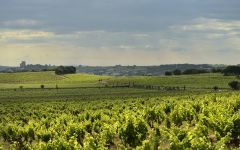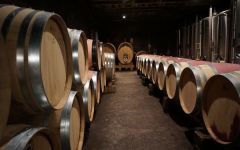Domaine de la Solitude Chateauneuf-du-Pape Le Vin de la Solitude 2019
-
James
Suckling -
Jeb
Dunnuck -
Wine
Spectator -
Robert
Parker



Product Details
Your Rating
Somm Note
Winemaker Notes
Floral nose with black berries and spices. A mouth with aromas of cassis, bouquet of garrigue. It is an elegant and refined wine, tannic while remaining fresh.
Blend: 30% Counoise, 25% Grenache noir, 15% Syrah, 15% Mourvèdre, 5% Clairette, 5% Bourboulenc, 5% Roussanne, Clairette rose, Grenache blanc
Professional Ratings
-
James Suckling
Intensely herbal, floral and spicy, this is a unique Chateauneuf that makes you feel like you’ve been beamed back to another age. Very graceful tannins and lively acidity on the seriously concentrated palate, the finish very mineral and vibrant. Made for the very long term! An eccentric blend of 30% counoise, 22% grenache, 22% serine, 17% mourvedre, 3% white and pink clairette, 3% bourboulenc, 2% roussanne, and 1% picpoul.
-
Jeb Dunnuck
The 2019 Châteauneuf Du Pape Le Vin De La Solitude is an interesting blend of 30% Counoise, 22% Grenache, 17% Mourvèdre, and the rest Clairette (both Rosé and Blanc), Bourboulenc, Roussanne, and Picpoul. Reminding me of a Grand Cru Red Burgundy with its finesse and elegance, it has a great perfume of red and black fruits as well as notes of peppery garrigue, chocolate, and spice. Medium to full-bodied, ultra-fine, seamless, and just thrilling stuff, I wouldn’t push the aging curve too much, but see no reason it won’t deliver the goods for at least a decade.
-
Wine Spectator
Very seductive, with a silky-textured core of pure, distilled raspberry essence that just won't quit as this stretches out through a gorgeous red tea, sandalwood, garrigue and floral-accented finish. Lingering minerality adds length too. Super-refined version. Counoise, Grenache, Syrah, Mourvèdre, Clairette, Bourboulenc, Roussanne and Grenache Blanc. Drink now.
-
Robert Parker's Wine Advocate
An intriguing whole-cluster, co-fermented blend that includes 30% Counoise, 22% each Grenache and Syrah, 17% Mourvèdre and the rest white varieties, the 2019 Chateauneuf du Pape Vin de la Solitude is herbal and stemmy on the nose, with those notes gradually giving way to red berries and stone fruit. It's medium to full-bodied, with firm tannins and a relentlessly greenish, tannic finish. Give it a few years in the cellar. Tasted twice (once blind), with consistent notes. Best after 2025
Other Vintages
2021-
James
Suckling -
Wine
Spectator -
Jeb
Dunnuck
-
James
Suckling -
Jeb
Dunnuck -
Robert
Parker -
Wine
Spectator






In the 1980s, brothers Michel and Jean Lançon took the future of Domaine de la Solitude in their hands, focusing attention on the vineyards. Fertilizers have not been used at Solitude for the past ten years. Over the past several years, Michel’s son Florent Lançon has been taking over the day-to-day operations of Domaine de la Solitude, continuing to make improvements while preserving the traditions of his father and uncle. The Estate is a contiguous 100 acres, planted to 86 acres of red grapes and 14.8 acres of white grapes, with vines averaging 50 years of age.
Driven by the desire to produce the best possible wines while still respecting the traditions of Chateauneuf-du-Pape and their lineage, in 1999, Michel and Jean decided to introduce four prestige cuvées and added Cuvée Barberini Rouge, Cuvée Barberini Blanc, Réserve Secrète, and Cornelia Constanza to the winery’s production.

With bold fruit flavors and accents of sweet spice, Grenache, Syrah and Mourvèdre form the base of the classic Rhône Red Blend, while Carignan, Cinsault and Counoise often come in to play. Though they originated from France’s southern Rhône Valley, with some creative interpretation, Rhône blends have also become popular in other countries. Somm Secret—Putting their own local spin on the Rhône Red Blend, those from Priorat often include Merlot and Cabernet Sauvignon. In California, it is not uncommon to see Petite Sirah make an appearance.

Famous for its full-bodied, seductive and spicy reds with flavor and aroma characteristics reminiscent of black cherry, baked raspberry, garrigue, olive tapenade, lavender and baking spice, Châteauneuf-du-Pape is the leading sub-appellation of the southern Rhône River Valley. Large pebbles resembling river rocks, called "galets" in French, dominate most of the terrain. The stones hold heat and reflect it back up to the low-lying gobelet-trained vines. Though the galets are typical, they are not prominent in every vineyard. Chateau Rayas is the most obvious deviation with very sandy soil.
According to law, eighteen grape varieties are allowed in Châteauneuf-du-Pape and most wines are blends of some mix of these. For reds, Grenache is the star player with Mourvedre and Syrah coming typically second. Others used include Cinsault, Counoise and occasionally Muscardin, Vaccarèse, Picquepoul Noir and Terret Noir.
Only about 6-7% of wine from Châteauneuf-du-Pape is white wine. Blends and single-varietal bottlings are typically based on the soft and floral Grenache Blanc but Clairette, Bourboulenc and Roussanne are grown with some significance.
The wine of Chateauneuf-du-Pape takes its name from the relocation of the papal court to Avignon. The lore says that after moving in 1309, Pope Clément V (after whom Chateau Pape-Clément in Pessac-Léognan is named) ordered that vines were planted. But it was actually his successor, John XXII, who established the vineyards. The name however, Chateauneuf-du-Pape, translated as "the pope's new castle," didn’t really stick until the 19th century.
